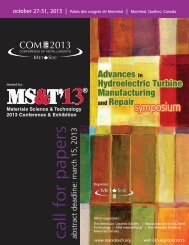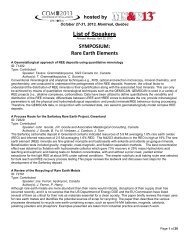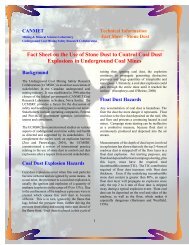hosted byOctober 27-31, 2013, Montreal, Quebec<strong>List</strong> <strong>of</strong> <strong>Speakers</strong>Revised: Monday, April 22, 2013<strong>SYMPOSIUM</strong>:<strong>Light</strong> <strong>Metals</strong> <strong>for</strong> <strong>Transportation</strong>Examination <strong>of</strong> these precipitates revealed a number <strong>of</strong> features, such as: (i) the composition <strong>of</strong> the precipitates is veryclose to the stochiometric Mg2Si compound; (ii) precipitates are aligned along dislocations; (iii) the precipitate density ismuch higher <strong>for</strong> the high pressure die castings where the a-Al matrix contains more dislocations than in permanent mouldcastings; (vi) precipitates lie inside the a-Al grains where they are randomly distributed. Between the Mg2Si lamellasprecipitates were not observed; (v) homogenization <strong>of</strong> the alloy results in complete dissolution <strong>of</strong> the precipitates andduring artificial aging new needle-shaped precipitates are <strong>for</strong>med.Modeling <strong>of</strong> Magnesium DC Casting Process Using a 3D Turbulent CFD ModelID: 73502Type: ContributedSpeaker: Mainul Hasan, McGill University, CanadaAuthor(s): M. Hasan, L. BegumA 3D CFD model <strong>of</strong> the direct chill (DC) casting <strong>of</strong> a magnesium rolling slab ingot has been modeled using an in-houseCFD code. The model is based on 3D time-averaged turbulent energy and Navier-Stokes equations and utilizes the‘enthalpy-porosity’ scheme to couple the solidification heat-transfer aspect <strong>of</strong> the problem with melt flow. Specifically, theDC casting <strong>of</strong> AZ31 alloy in a hot-top mold has been modeled <strong>for</strong> the steady state operation. Simulations are carried out<strong>for</strong> five different casting speeds , ranging from 60 to 180 mm/min and <strong>for</strong> two melt superheats <strong>of</strong> 32C and 64C The meltvelocityand temperature pr<strong>of</strong>iles are presented along with the sump depth and sump pr<strong>of</strong>ile, shell thickness and localheat fluxes along the outer surfaces <strong>of</strong> the cast. The model can be used to predict the upper limit <strong>of</strong> the casting speedwhich might lead to an unwanted break-out during production runs.Near Net Shaped Casting <strong>of</strong> Heat Treatable Al-Zn-Mg-Cu Wrought Alloy by Controlled Diffusion SolidificationProcess (CDS): Microstructure, Mechanical Properties and Heat TreatmentID: 73149Type: StudentSpeaker: Reza Ghiaasiaan, McMaster University, CanadaAuthor(s): R. Ghiaasiaan, X. Zeng, S. ShankarIn Controlled diffusion solidification (CDS), two differently thermal mass precursor alloys are mixed and subsequently theresultant mixture cast into near net shaped cast component. The CDS process enables casting <strong>of</strong> the Al wrought alloysinto near net shaped components by mitigating the problem <strong>of</strong> hot tearing through ensuring a non-dendritic morphology <strong>of</strong>primary Al-phase. The study presents the favorable process and alloy parameters <strong>for</strong> sound shaped casting <strong>of</strong> 7xxx Alwroughtalloy (Al-Zn-Mg-Cu-(Si)) by the CDS process along with the mechanical tensile properties under various heattreatment conditions. The tilt pour gravity casting process was used <strong>for</strong> this study to demonstrate the ability to cast highintegrity components with high strength and ductility. In depth microstructure analysis outlining the phased in the cast andheat treated microstructure would also be presented.Numerical approach <strong>for</strong> development <strong>of</strong> high elastic casting aluminum alloys.ID: 71987Type: ContributedSpeaker: Kyung-Moon Lee, Hyundai Motor, Korea SouthAuthor(s): K. Lee, H. Lee, H. Park, H. ParkThe elastic modulus <strong>of</strong> aluminum alloys is important to enhance the stiffness <strong>of</strong> automobile parts that it could replace theengine block material to aluminum alloy from cast iron. This study is suggested how to make high elastic aluminum alloysusing computational material science (thermodynimic, first pricipal caculation and Eshelby's theory) and evaluatedmechanical properties <strong>of</strong> rein<strong>for</strong>ced phases (TiB2, AlB2, Al3Ti). The volume fraction, shape, aspect ratio and distributionPage 10 <strong>of</strong> 17
hosted byOctober 27-31, 2013, Montreal, Quebec<strong>List</strong> <strong>of</strong> <strong>Speakers</strong>Revised: Monday, April 22, 2013<strong>SYMPOSIUM</strong>:<strong>Light</strong> <strong>Metals</strong> <strong>for</strong> <strong>Transportation</strong><strong>of</strong> particles effect on the mechanical properties <strong>of</strong> new aluminum alloy such as elastic modulus and yield/tensile stress.Through these approaches, high elastic modulus aluminum alloys could be developing to adjust the engine blockmaterials.Numerical Modeling and Experimental Validation <strong>of</strong> AA5000 Series Alloy Strips, Containing Sc and Zr, Cast onthe Horizontal Single Belt Casting (HSBC) MachineID: 73170Type: ContributedSpeaker: Sa Ge, McGill University, CanadaAuthor(s): S. Ge, M. Celikin, M. Isac, R. GuthrieThe Horizontal Single Belt Casting (HSBC) is a near-net-shape casting process in which molten metal is directly cast intothin strips at high cooling rates. This process has been gaining significant traction. It was used in the present work toproduce strips <strong>of</strong> Al-Mg alloys (AA5000 series). This particular AA5000 series alloy with additions <strong>of</strong> Sc and Zr, showexceptional potential as structural materials <strong>for</strong> transportation applications, and are ideal materials to be produced usingthe HSBC process.Computational Fluid Dynamics (CFD simulations using ANSYS FLUENT 14, were carried out toassess various transport phenomena during the casting <strong>of</strong> Al-Mg-Sc-Zr alloys. Numerical predictions were validatedagainst experimental results. Optical microscopy, SEM and EBSD analyses were conducted to compare the advantages<strong>of</strong> Al-Mg-Sc-Zr alloys produced by the HSBC process over those produced conventionally.Numerical Simulation <strong>of</strong> Flow,Temperature and Composition Variation in the Snout and Sink Roll Region <strong>of</strong>Continuous Galvanizing BathsID: 71831Type: ContributedSpeaker: Frank Ajersch, Ecole Polytechnique, CanadaAuthor(s): F. Ajersch, F. Ilinca, F. GoodwinThe snout and sink roll regions <strong>of</strong> a continuous galvanizing operation are <strong>of</strong> critical importance in achieving automotivequality coated steel products. Entrainment <strong>of</strong> dross particles into the coating originating in the snout and in the pinchbetween the strip and sink roll were investigated. Numerical simulations were carried out by introducing a pumping systemwhich can direct flow to these specific ares.Velocity, temperature and compositional gradients were calculated andcompared to the standard configuration not using pumps. The results showed that the quality <strong>of</strong> the coated steel can beimproved using an imposed flow system.Optimum Ageing Cycles in Multiple-Step Ageing <strong>of</strong> Aluminum AlloysID: 70927Type: ContributedSpeaker: Adebayo Badmos, Black Hawk College, USAAuthor(s): A. Badmos, A. OdeshiMultiple-ageing <strong>of</strong> aluminum alloys are usually limited to two steps with no in<strong>for</strong>mation on the effects <strong>of</strong> higher number <strong>of</strong>steps. This paper investigates the optimum number <strong>of</strong> ageing cycles in the multiple ageing <strong>of</strong> three aluminum alloys,2017, 2024 and 2624 by means <strong>of</strong> hardness test. The three alloys are aluminum-copper systems with close chemicalcompositions and common strengthening precipitates. The multiple-step aging treatment involves solutionizing andquenching the alloy, reheating the alloy to a lower temperature and pre-aging <strong>for</strong> a given time, and subsequentlyrepeating the aging step <strong>for</strong> a number <strong>of</strong> times at either the same or different temperature from the preceding agingtreatment. The aim is to determine the optimum number <strong>of</strong> ageing cycles and its dependence on aging temperature andtime.Page 11 <strong>of</strong> 17
- Page 1 and 2: hosted byOctober 27-31, 2013, Montr
- Page 3 and 4: hosted byOctober 27-31, 2013, Montr
- Page 5 and 6: hosted byOctober 27-31, 2013, Montr
- Page 7 and 8: hosted byOctober 27-31, 2013, Montr
- Page 9: hosted byOctober 27-31, 2013, Montr
- Page 13 and 14: hosted byOctober 27-31, 2013, Montr
- Page 15 and 16: hosted byOctober 27-31, 2013, Montr
- Page 17: hosted byOctober 27-31, 2013, Montr


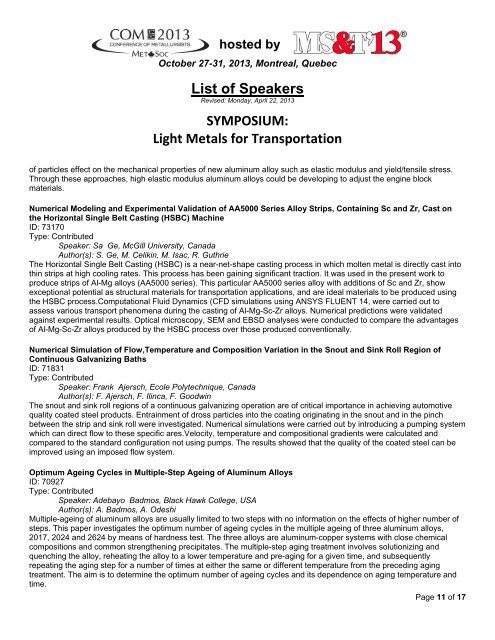

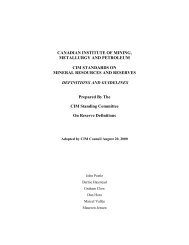
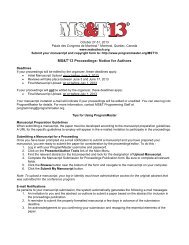


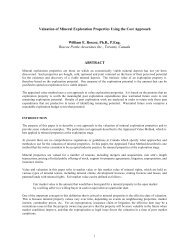
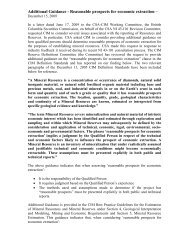
![Richard Wright - NORWEST Corporation [PDF]](https://img.yumpu.com/34320526/1/190x245/richard-wright-norwest-corporation-pdf.jpg?quality=85)
